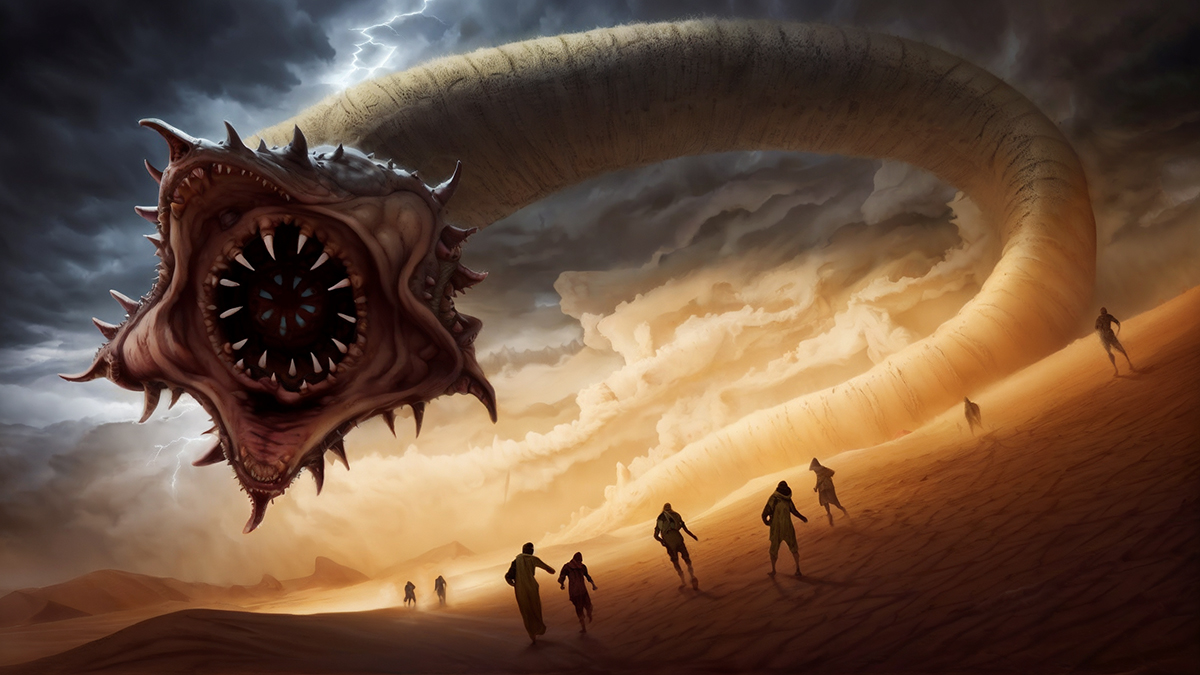The Mongolian Death Worm is a giant worm-like cryptid said to live in the sands of the Gobi Desert. The terrifying creature has deadly venom.
Description
Olghoi-Khorkoi is Mongolian for “large intestine worm,” otherwise known as the Mongolian Death Worm.
Local tribesmen have told tales of the worm for generations; however, there has never been a confirmed sighting. Expeditions have been mounted on various occasions, but these, too, have been fruitless.
Although the Mongolian Death Worm has been part of local lore for generations, it wasn’t until the 1920s that the creature became known to the Western world.
Roy Chapman Andrew, a paleontologist (and, apparently, the inspiration for the Indiana Jones character), described the worm in his 1926 book, On the Trail of Ancient Man. Andrew himself was skeptical about its existence.
The foremost investigator of the Mongolian Death Worm is a Czech cryptozoologist named Ivan Mackerle. After hearing of the creature from a student, Ivan went to Mongolia to try to find out more.
He found it tricky to glean any information, and the locals were reluctant to speak about the legendary creature. On top of this, the government had banned searches for the worm. (This ban was eventually lifted.)
It is Ivan who provides a detailed description of the worm. He says the worm is sausage-like, around 20 inches long, and as thick as a man’s arm. It is red in color, and its skin is an exoskeleton – molting whenever the worm is hurt. The tail is short but is not tapered.
The worm-like qualities are most recognizable from his description of the head; Ivan purports that the creature does not have any visible eyes, nostrils, or mouth.
The red color is thought to be because the worm lays its eggs in a camel’s stomach, thus acquiring a red color.
Other descriptions of the worm are somewhat more vivid. Legend says that the worm is up to 3 feet long and looks like a bulging, blood-red intestine.
It is also said to have a gaping mouth with teeth that point inwards and a spiky, pointed rear end with the ability to squirt acid or venom. Some stories claim the creature can produce electricity.
Living under the sand, the worms allegedly shoot up to the surface and attack their prey. They are thought to come to the surface after there has been rain.
The worms are said to move by rolling around or squirming sideways. Although they are believed to attack camels and rodents, humans can be vulnerable too.
The worms are believed to hibernate, being active only in June and July. Locals believe that you will die if you touch any part of the worm.
Dr. Karl Shuker, well known in cryptozoological circles, has a theory that the Mongolian Death Worm may be a large species of amphisbaenian (a generally limbless, burrowing lizard that lives in warm climates).
Other scientists have speculated that the descriptions roughly match the appearance of the death adder, which is part of the cobra snake family. Some have suggested the Death Worm may be a Tartar Sand Boa, a snake that often appears round and thick.
Sightings and Tales
No confirmed sightings have been made, but there are many similarities between the various accounts. Despite countless reports of encounters, no photo of the creature has ever been taken.
Russian scientists are thought to have discovered a dead specimen in 1972, but this specimen disappeared and is rumored to be in the basement of a Russian museum.
The creature has certainly generated a great deal of interest and speculation over time, with the National Geographic Channel even commissioning a series about it.
One of Ivan Mackerle’s guides told him a story about a geologist who was killed during a field trip many years previously. The geologist had been poking a metal rod into the sand when, suddenly, he dropped to the ground.
His colleagues rushed over and found him dead. They then saw the sand begin to churn, and an enormous, fat death worm burst out.
Eyewitnesses tend to be reliable, including park rangers, a police officer, and a colonel in the Mongolian army. A Mongolian prime minister also professed to believe in the creature.
A Mongolian prime minister once warned that the death worm was so poisonous that a mere touch would cause certain death.
Accounts of giant and violent worms are incredibly old. In the 5th century BC, Greek physician and historian, Ctesias wrote the book on strange creatures supposedly found in India. Ctesias on India described a creature known as the Indus Worm, which was two meters long and would come out of the ground to devour humans.
| Other Name/s | Olghoi-Khorkhoi, Olgoi Chorchoi |
| Location | China, Mongolia, |
| Type | Monster |
| Habitat | Desert |
References
ancient-origins.net, “Finding the Legendary Mongolian Death Worm,” accessed October 09, 2017,
virtuescience.com, “The Mongolian Death Worm,” accessed October 9, 2017,
karlshuker.blogspot.co.uk, “THE MONGOLIAN DEATH WORM – A SHOCKING SURPRISE IN THE GOBI?” accessed October 9, 2017,
mongolia-travel-guide.com, “The Mongolian Death Worm,” accessed October 09, 0217.
